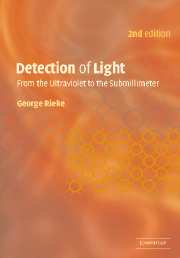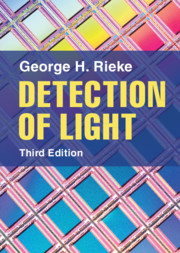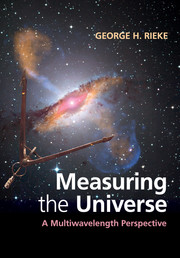Detection of Light
How does a quantum well detector, a silicon BIB or a CCD work? How are heterodyne techniques used in infrared detectors and submillimeter receivers? And how do you specify the performance of any detector system? This volume answers all these questions with an up-to-date review of all the techniques for the detection of radiation. This presentation approaches detectors from the perspective of the underlying physics; and in this way it provides a unified understanding of the detection of radiation in the ultraviolet through to the submillimetre. Clearly worked examples demonstrate the physics involved and problems are provided to increase the reader's knowledge of how each system works. This clearly written and authoritative review of modern detector systems will develop the understanding of final year undergraduate and graduate students, and will provide a valuable reference for professionals in astronomy, engineering and physics.
- An up-to-date review of all radiation detector systems for the UV
- A self-contained textbook of the physics involved in all detector systems
- Clearly-written problems and fully worked examples to develop your understanding
Reviews & endorsements
'In summary this is a must for anyone involved in millimetre-to-ultraviolet instrumentation, and will also be of interest to the non-specialist who wants to keep abreast of photo-detection technology.' Observatory
'This book is clearly and authoritatively written, and should appeal to astronomers, engineers and physicists, and prove particularly useful to the advanced university student.' Irish Astronomical Journal
'Although on the face of it a hard science volume, this book is still quite readable. This is due to the progressive stye in which each topic is approached ... this book does provide a complete introduction and reference volume to the world of photon detection.' Alex Colburn, Webb Society Reviews
'… providing in a single source a comprehensive, up-to-date overview of the field. Whether used as a text or as a reference … an invaluable addition.' Physics Today
'The book is well laid out and covers most of the basic solid state physics required to understand how the various types of detectors work. I found the diagrams very clear and the examples well thought through … It is certainly a book that I wish I had had available as an undergraduate when studying detection systems in astronomy.' Owen Brazell, Astronomy Now
' … a valuable addition to the library … the physics/astronomy/engineering community owes Professor Rieke a debt of gratitude for writing this comprehensive book.' Peter Cockshott, Measurement Science and Technology
'An excellent treatise on the physics behind … a very broad range of detectors … It is well presented and each chapter is provided with worked examples and problems to test understanding … can be recommended to anyone in the field using light detectors of any sort …'. Engineering Science and Education Journal
'This book is an excellent guide … and will be of value to a wide-ranging readership … the layout is extremely clear and approachable … [and] the emphasis throughout is on the basic physical processes which underlie each technology … In summary, this is a must for anyone involved in millimeter-to-ultraviolet instrumentation …'. Observatory
' … a consistently lucid exposition … each topic covered is sufficiently self-contained to allow a reader to dip into any chapter without having to search for prerequisite information elsewhere … providing in a single source a comprehensive, up-to-date overview of the field. Whether used as a text or a reference … an invaluable addition …'. Physics Today
Product details
No date availablePaperback
9780521576741
358 pages
247 × 175 × 23 mm
0.64kg
91 b/w illus. 19 tables 73 music examples 73 exercises
Table of Contents
- 1. Introduction
- 2. Photography
- 3. Intrinsic photoconductors
- 4. Extrinsic semiconductors
- 5. Photodiodes
- 6. Amplifiers and readouts
- 7. Arrays
- 8. Photoemissive detectors
- 9. Bolometers
- 10. Visible and infrared coherent receivers
- 11. Submillimeter- and millimeter-wave heterodyne receivers
- 12. Summary.







